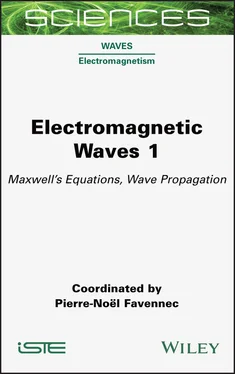The electromagnetic field is the set of vector fields  . The properties of the electromagnetic field at a point in space are determined by the properties of the electric field
. The properties of the electromagnetic field at a point in space are determined by the properties of the electric field  and the magnetic field
and the magnetic field  at a point. In physics, the term “field” refers to the situation where we are in the presence of a physical magnitude distributed in a given region of space. This magnitude has a value determined at each point in this space and at all times. Having an area of space where there is an electromagnetic field, means that at each point in this space, we have two vector variables
at a point. In physics, the term “field” refers to the situation where we are in the presence of a physical magnitude distributed in a given region of space. This magnitude has a value determined at each point in this space and at all times. Having an area of space where there is an electromagnetic field, means that at each point in this space, we have two vector variables  and
and  .
.
Electromagnetic waves are produced by excited matter. The deexcitation of the excited source produces around it a periodic variation of the electromagnetic field which propagates gradually in the vacuum at the phase speed (or propagation speed) close to 300,000 km per second. Depending on their emission frequency domain, they have different names: radio waves for the lowest frequencies, infrared waves, visible optical waves, then ultraviolet, then for the highest frequencies, X-rays and gamma rays. The electromagnetic wave propagates: a variable electric field generates a variable magnetic field and conversely a variable magnetic field generates a variable electric field. The conjoint propagation of these variations in a region constitutes a continuous wave phenomenon, capable of propagating (across the vacuum at 300,000 kilometers per second), transporting energy without the need for material support.
Waves are vibrations that propagate from one place to another in space, in a material medium or in a vacuum. Electromagnetic vibrations (electromagnetic waves) are waves obeying the laws of electromagnetism. Mechanical vibrations (pendulum, acoustics, etc.) obey the laws of mechanics, but often these mechanical vibrations are in fact fundamentally electromagnetic, due to the electromagnetic interactions of atoms and molecules of materials; they are described by “approximate” laws according to movements following the laws of mechanics.
Characterizing or measuring an electromagnetic field is carried out via current or voltage measurements. The electromagnetic field located in one place is the set of vector fields  . Sensors or antennas measure, at a given point, the currents or voltages resulting from the field from the different vector magnitudes
. Sensors or antennas measure, at a given point, the currents or voltages resulting from the field from the different vector magnitudes  and
and  . Subsequent processing can, if useful, select the different frequencies.
. Subsequent processing can, if useful, select the different frequencies.
In our everyday life, the environmental electromagnetic field does not arise from a single source. There are fields of natural origin (the sun, galaxy, geomagnetism, etc.) and those of human origin (household materials, transport, telecommunications, energy supply, etc.). Each point on the planet is subjected to a fairly intense electromagnetic “bath” depending on its location. The drawing below, envisaged by Michel Urien, shows that we are all “willingly” bathed in these electromagnetic waves. Let us try to understand our electromagnetic environment !

Figure P.1. A wave bath envisaged by Michel Urien1
This referenced work, presented in two inseparable volumes, is essential for any student, engineer or researcher wishing to understand electromagnetism and all the technologies derived from it.
Volume 1is oriented towards the basic phenomena explaining electromagnetism: the famous Maxwell equations – essential to know – then the propagation phenomena of electromagnetic waves. It only concerns non-ionizing radiation, which is radiation from waves whose energies are insufficient to ionize an atom, that is to say incapable of removing an electron from matter. This excludes all radiation with an energy greater than 12.4 eV, that is that generated by X-ray and gamma ray emitters. This work is made up of two chapters.
In Chapter 1, Ibrahima Sakhopresents the Maxwell equations as clearly as possible. These equations are essential to comprehensively approach electromagnetism and all its derived fields such as radioelectricity, photonics, geolocation, measurement, telecommunications, medical imagery, radio astronomy, etc.
In Chapter 2, Hervé Sizundescribes the propagation phenomena of electromagnetic, radio and photonic waves. Many factors, often complex, must be taken into account to properly understand these propagation problems in free and sometimes confined spaces.
In Volume 2, Jean-Pierre Blot, expert in radio antennas of all configurations, directs his analysis towards antennas, essential elements for the detection of electromagnetic waves, their characterization and use. This volume is intended to describe what an effective antenna should be, according to various parameters and conditions of use. It does not address the detection problems specific to photonics. Photonics and these detection problems will be seen in a future publication of the “Waves” series.
Important appendices with essential information, presenting in particular mathematical tools, complete these two volumes.
Cartini, R. (1993). Panorama encyclopédique des sciences . Belin, Paris.
de Fornel, F., Favennec, P.-N. (eds) (2007). Mesures en électromagnétisme. Revue RS série I2M , 7(1–4).
Favennec, P.-N. (2008). Mesures de l’exposition humaine aux champs radio-électriques – Environnement radioélectrique . Techniques de l’Ingénieur, Saint-Denis.
Serres, M., Farouki, N. (1997). Dictionnaire des sciences . Flammarion, Paris.
For a color version of all figures in this book, see www.iste.co.uk/favennec/electromagnetic1.zip.
1 1 Source: www.armorscience.com.
Конец ознакомительного фрагмента.
Текст предоставлен ООО «ЛитРес».
Прочитайте эту книгу целиком, купив полную легальную версию на ЛитРес.
Безопасно оплатить книгу можно банковской картой Visa, MasterCard, Maestro, со счета мобильного телефона, с платежного терминала, в салоне МТС или Связной, через PayPal, WebMoney, Яндекс.Деньги, QIWI Кошелек, бонусными картами или другим удобным Вам способом.

 . The properties of the electromagnetic field at a point in space are determined by the properties of the electric field
. The properties of the electromagnetic field at a point in space are determined by the properties of the electric field  and the magnetic field
and the magnetic field  at a point. In physics, the term “field” refers to the situation where we are in the presence of a physical magnitude distributed in a given region of space. This magnitude has a value determined at each point in this space and at all times. Having an area of space where there is an electromagnetic field, means that at each point in this space, we have two vector variables
at a point. In physics, the term “field” refers to the situation where we are in the presence of a physical magnitude distributed in a given region of space. This magnitude has a value determined at each point in this space and at all times. Having an area of space where there is an electromagnetic field, means that at each point in this space, we have two vector variables  and
and  .
. . Sensors or antennas measure, at a given point, the currents or voltages resulting from the field from the different vector magnitudes
. Sensors or antennas measure, at a given point, the currents or voltages resulting from the field from the different vector magnitudes  and
and  . Subsequent processing can, if useful, select the different frequencies.
. Subsequent processing can, if useful, select the different frequencies.











